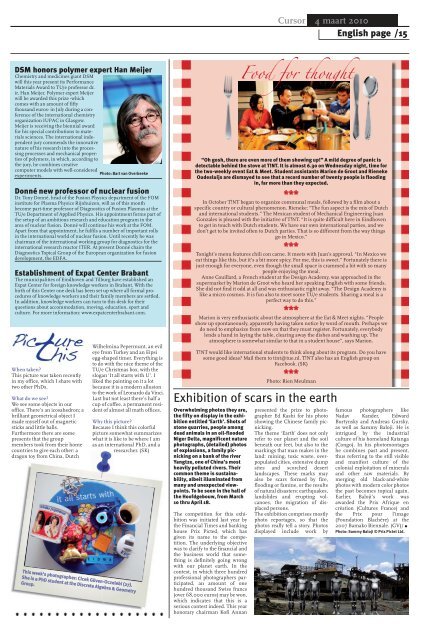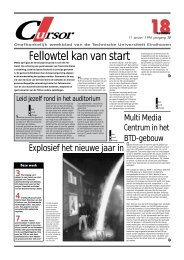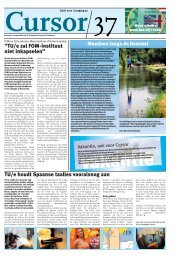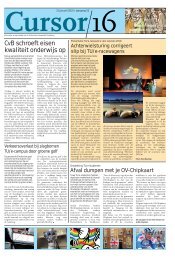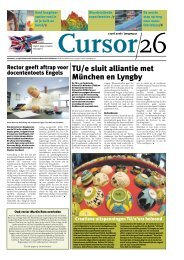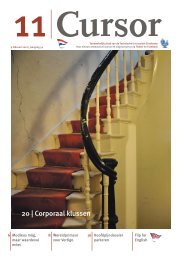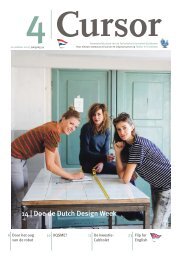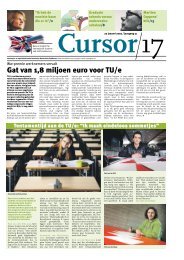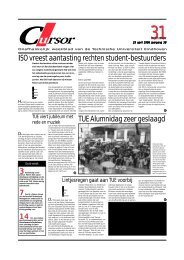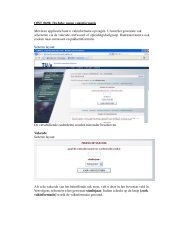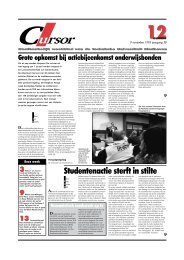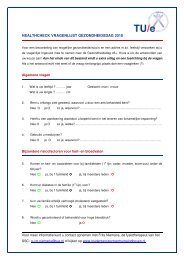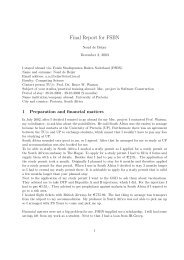Twentse procestechnologen naar TU/e - Technische Universiteit ...
Twentse procestechnologen naar TU/e - Technische Universiteit ...
Twentse procestechnologen naar TU/e - Technische Universiteit ...
You also want an ePaper? Increase the reach of your titles
YUMPU automatically turns print PDFs into web optimized ePapers that Google loves.
DSM honors polymer expert Han Meijer<br />
Chemistry and medicines giant DSM<br />
will this year present its Performance<br />
Materials Award to <strong>TU</strong>/e professor dr.<br />
ir. Han Meijer. Polymer expert Meijer<br />
will be awarded this prize -which<br />
comes with an amount of fifty<br />
thousand euros- in July during a conference<br />
of the international chemistry<br />
organization IUPAC in Glasgow.<br />
Meijer is receiving the biennial award<br />
for his special contributions to materials<br />
sciences. The international independent<br />
jury commends the innovative<br />
nature of his research into the processing<br />
processes and mechanical properties<br />
of polymers, in which, according to<br />
the jury, he combines creative<br />
computer models with well-considered<br />
Photo: Bart van Overbeeke<br />
experiments.<br />
Donné new professor of nuclear fusion<br />
Dr. Tony Donné, head of the Fusion Physics department of the FOM<br />
institute for Plasma Physics Rijnhuizen, will as of this month<br />
become part-time professor of Diagnostics of Fusion Plasmas at the<br />
<strong>TU</strong>/e Department of Applied Physics. His appointment forms part of<br />
the setup of an ambitious research and education program in the<br />
area of nuclear fusion. Donné will continue his work at the FOM.<br />
Apart from that appointment, he fulfils a number of important rolls<br />
in the international world of nuclear fusion. Until recently he was<br />
chairman of the international working group for diagnostics for the<br />
international research reactor ITER. At present Donné chairs the<br />
Diagnostics Topical Group of the European organization for fusion<br />
development, the EDFA.<br />
Establishment of Expat Center Brabant<br />
The municipalities of Eindhoven and Tilburg have established an<br />
Expat Center for foreign knowledge workers in Brabant. With the<br />
birth of this Center one desk has been set up where all formal procedures<br />
of knowledge workers and their family members are settled.<br />
In addition, knowledge workers can turn to this desk for their<br />
questions about accommodation, moving, education, sport and<br />
culture. For more information: www.expatcenterbrabant.com.<br />
When taken?<br />
This picture was taken recently<br />
in my office, which I share with<br />
two other PhDs.<br />
What do we see?<br />
We see some objects in our<br />
office. There’s an icosahedron; a<br />
brilliant geometrical object I<br />
made myself out of magnetic<br />
sticks and little balls.<br />
Furthermore there are some<br />
presents that the group<br />
members took from their home<br />
countries to give each other: a<br />
dragon toy from China, Dutch<br />
Wilhelmina Pepermunt, an evil<br />
eye from Turkey and an Eipsi<br />
egg-shaped timer. Everything is<br />
to do with the nice theme of the<br />
<strong>TU</strong>/e Christmas box, with the<br />
slogan ‘It all starts with U’. I<br />
liked the painting on it a lot<br />
because it is a modern allusion<br />
to the work of Leonardo da Vinci.<br />
Last but not least there’s half a<br />
cup of coffee, a permanent resident<br />
of almost all math offices.<br />
Why this picture?<br />
Because I think this colorful<br />
picture somewhat summarizes<br />
what it is like to be where I am<br />
as an international PhD, and a<br />
researcher. (SK)<br />
Thhiiss weeeekk’s pphottoogrraapphheer: CCiicceekk GGüvenn-OOcczeleebbii ((2277)..<br />
SShhee iis a PPhhD stuuddeenntt aatt tthhee DDiissccrettee AAllggeebbraa && Geeommeetrryy<br />
GGrooupp..<br />
Cursor 4 maart 2010<br />
English page /15<br />
Food for thought<br />
“Oh gosh, there are even more of them showing up!” A mild degree of panic is<br />
detectable behind the stove at T!NT. It is almost 6.30 on Wednesday night, time for<br />
the two-weekly event Eat & Meet. Student assistants Marion de Groot and Rieneke<br />
Oudesluijs are dismayed to see that a record number of twenty people is flooding<br />
in, far more than they expected.<br />
***<br />
In October T!NT began to organize communal meals, followed by a film about a<br />
specific country or cultural phenomenon. Rieneke: “The fun aspect is the mix of Dutch<br />
and international students.” The Mexican student of Mechanical Engineering Juan<br />
Gonzales is pleased with the initiative of T!NT. “It is quite difficult here in Eindhoven<br />
to get in touch with Dutch students. We have our own international parties, and we<br />
don’t get to be invited often to Dutch parties. That is so different from the way things<br />
go in Mexico.”<br />
***<br />
Tonight’s menu features chili con carne. It meets with Juan’s approval. “In Mexico we<br />
eat things like this, but it’s a bit more spicy. For me, this is sweet.” Fortunately there is<br />
just enough for everyone, even though the small space is crammed a bit with so many<br />
people enjoying the meal.<br />
Anne Couillard, a French student at the Design Academy, was approached in the<br />
supermarket by Marion de Groot who heard her speaking English with some friends.<br />
She did not find it odd at all and was enthusiastic right away. “The Design Academy is<br />
like a micro cosmos. It is fun also to meet some <strong>TU</strong>/e students. Sharing a meal is a<br />
perfect way to do this.”<br />
***<br />
Marion is very enthusiastic about the atmosphere at the Eat & Meet nights. “People<br />
show up spontaneously, apparently having taken notice by word of mouth. Perhaps we<br />
do need to emphasize from now on that they must register. Fortunately, everybody<br />
lends a hand in laying the table, clearing away the dishes and washing up. The<br />
atmosphere is somewhat similar to that in a student house”, says Marion.<br />
T!NT would like international students to think along about its program. Do you have<br />
some good ideas? Mail them to tint@tue.nl. T!NT also has an English group on<br />
Facebook. (SK)<br />
***<br />
Photo: Rien Meulman<br />
Exhibition of scars in the earth<br />
Overwhelming photos they are,<br />
the fifty on display in the exhibition<br />
entitled ‘Earth’. Shots of<br />
stone quarries, people among<br />
dead animals in an oil-flooded<br />
Niger Delta, magnificent nature<br />
photographs, (detailed) photos<br />
of explosions, a family picnicking<br />
on a bank of the river<br />
Yangtze, one of China’s most<br />
heavily polluted rivers. Their<br />
common theme is sustainability,<br />
albeit illuminated from<br />
many and unexpected viewpoints.<br />
To be seen in the hall of<br />
the Hoofdgebouw, from March<br />
10 thru April 18.<br />
The competition for this exhibition<br />
was initiated last year by<br />
the Financial Times and banking<br />
house Prix Picted, which has<br />
given its name to the competition.<br />
The underlying objective<br />
was to clarify to the financial and<br />
the business world that something<br />
is definitely going wrong<br />
with our planet earth. In the<br />
contest, in which three hundred<br />
professional photographers participated,<br />
an amount of one<br />
hundred thousand Swiss francs<br />
(over 68,000 euros) may be won,<br />
which indicates that this is a<br />
serious contest indeed. This year<br />
honorary chairman Kofi Annan<br />
presented the prize to photographer<br />
Ed Kashi for his photo<br />
showing the Chinese family picnicking.<br />
The theme ‘Earth’ does not only<br />
refer to our planet and the soil<br />
beneath our feet, but also to the<br />
markings that man makes in the<br />
land: mining, toxic waste, overpopulated<br />
cities, extensive dump<br />
sites and scorched desert<br />
landscapes. These marks may<br />
also be scars formed by fire,<br />
flooding or famine, or the results<br />
of natural disasters: earthquakes,<br />
landslides and erupting volcanoes,<br />
the migration of displaced<br />
persons.<br />
The exhibition comprises mostly<br />
photo reportages, so that the<br />
photos really tell a story. Photos<br />
displayed include work by<br />
famous photographers like<br />
Nadav Kander, Edward<br />
Burtynsky and Andreas Gursky,<br />
as well as Sammy Baloji. He is<br />
intrigued by the industrial<br />
culture of his homeland Katanga<br />
(Congo). In his photomontages<br />
he combines past and present,<br />
thus referring to the still visible<br />
and manifest culture of the<br />
colonial exploitation of minerals<br />
and other raw materials. By<br />
merging old black-and-white<br />
photos with modern color photos<br />
the past becomes topical again.<br />
Earlier, Baloji’s work was<br />
awarded the Prix Afrique en<br />
création (Cultures France) and<br />
the Prix pour l’image<br />
(Foundation Blachère) at the<br />
2007 Bamako Biennale. (GV)/.<br />
Photo: Sammy Baloji © Prix Pictet Ltd.


